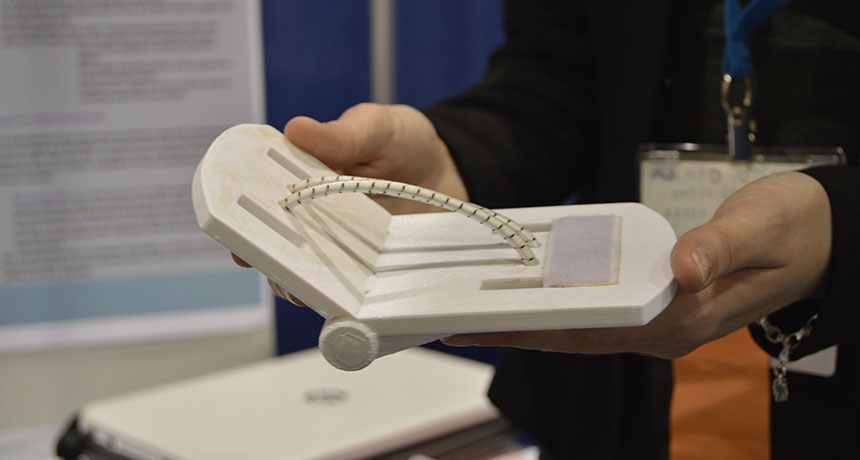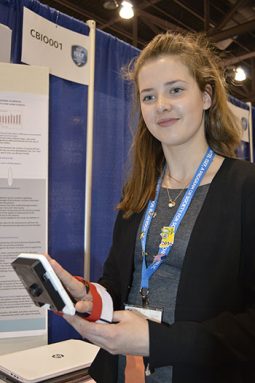Helping MS patients get a grip on things
New device helps patients with multiple sclerosis counter the onset of a debilitating symptom

An Irish teen has invented a device that helps strengthen muscles in the fingers and hands. She designed it for of patients with multiple sclerosis who are losing their grip on things.
M. Chertock / SSP
By Sid Perkins
PHOENIX, Ariz. — Hundreds of thousands of people in the United States alone suffer from multiple sclerosis. This nervous system disease gradually leads to widespread paralysis. But in most cases, MS patients first lose the ability to open their hands. In time they lose the ability to grip common household items. Now, a teen has invented a device that helps slow the development of this “clenched fist” condition.
Affected people typically have tightly curled fingers. They can’t open their hand on their own, notes Lauren Murphy. The 17-year-old attends Loreto Secondary School in Balbriggan, Ireland. Their permanently clenched fists make it difficult for MS patients to grip pencils or lift something like a cup of tea.
Lauren knows well the impacts this can have on a patient’s life from watching her dad. Like more than eight out of 10 MS patients, his hands have clenched up.
There aren’t many treatments for clenched fist, Lauren notes. Physical therapists often suggest flexing and exercising the hand to strengthen its muscles. However, there are no easy-to-use devices for patients to work with on their own. That’s why she decided to make one.
Lauren described this hand-exercising aid on May 12 at the Intel International Science and Engineering Fair. Created by Society for Science & the Public and sponsored by Intel, this year’s competition brought together more than 1,750 students from 75 countries. (Society also publishes Science News for Students.)
Lauren first tried to modify a splint that’s used to hold an MS patient’s hand open, with fingers extended. Therapists often apply these splints, made of plastic, as part of a patient’s rehabilitation program. For this version, Lauren sawed the splint across its palm. Then she reattached the pieces in their original arrangement, using strong tape. This allowed the fingers to flex and exercise. But that design had a flaw. It only let the fingers flex through a small angle. Another painful problem: As the pieces flexed back and forth, they sometimes pinched the user’s palm.
So Lauren revised her design. She used a three-dimensional printer to make two small paddles out of plastic. One is slightly larger than someone’s palm; the other is slightly smaller. She attached them to each other along one edge with a rotating joint (something like the hinge on a door). That hinge allows the wide range of flexing that Lauren had been looking for. Plus, no pinching!
During therapy sessions, patients strap one hand to the larger paddle. This stretches their fingers out across the device’s hinge line and onto the smaller paddle. Pulling their outstretched fingers toward their palms stretches two small bungee cords. These provide resistance. That resistance helps exercise finger muscles. The spring-like cords also pull the paddles back into their original position after each flex. This allows users to repeat the exercise as often as needed.
The device worked well in tests with several MS patients who had developed the clenched fist condition, Lauren notes. For two weeks, each volunteer used the device daily to strengthen their hand muscles. After each day’s session, the patients would grab a pencil or lift a cup of water as many times as they could in 5 minutes. (These tests are commonly used by physical therapists too, Lauren notes.) On day one, patients typically picked a pencil up from a tabletop about 10 times in 5 minutes. By the end of the two weeks, they could now pick up the pencil more than 30 times in 5 minutes.
Later versions of Lauren’s device have improvements that help monitor a patient’s progress. She added a sensor, for instance, to measure the angle through which the hinge rotates. (The farther it rotates, the better the patient is performing.) She also added sensors that measure the force that patients exert on the paddle beneath their extended fingers. (The more force they can exert, the better, Lauren notes.) A small computer gathers those data so that doctors can assess the patient’s progress.

Educators and Parents, Sign Up for The Cheat Sheet
Weekly updates to help you use Science News Explores in the learning environment
Thank you for signing up!
There was a problem signing you up.







